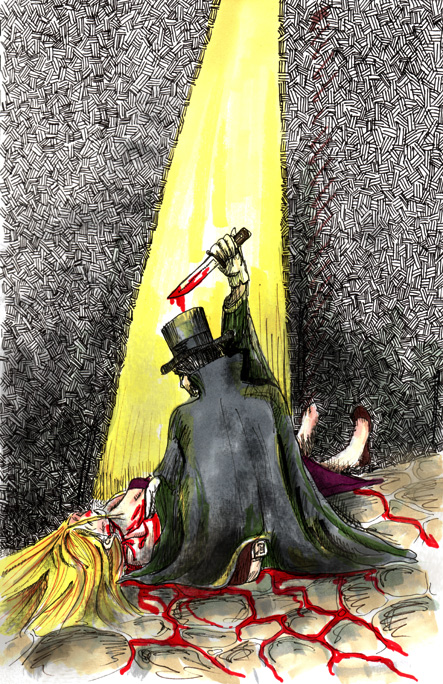The challenge from Illustration Friday this week is “tales and legends“.

Beginning in early 1888, several violent attacks and brutal murders, mainly prostitutes, occurred in rapid succession in and around the Whitechapel area of London. A number of the murders featured extremely gruesome acts, such as mutilation and evisceration. Rumors that the murders were connected intensified in September and October, when a series of extremely disturbing letters were received by various media outlets and Scotland Yard, purporting to take responsibility for some or all of the murders. One letter, received by George Lusk of the Whitechapel Vigilance Committee, included a preserved human kidney.
Files kept by the Metropolitan police show that the investigation begun in 1888 eventually came to include eleven separate murders stretching from April 1888, until February 1891. These became known as “the Whitechapel Murders.”
Among the eleven murders actively investigated by the police, five are almost universally agreed upon as having been the work of a single serial killer. These are known collectively as the canonical five victims of Jack the Ripper. These victims were:
Mary Ann Nichols, killed on August 31, 1888. Nichols’ body was discovered at about 3:40 in the morning on the ground in front of a gated stable entrance in Buck’s Row, a back street in Whitechapel two hundred yards from the London Hospital.
Annie Chapman, killed on September 8, 1888. Chapman’s body was discovered about 6:00 in the morning lying on the ground near a doorway in the back yard of 29 Hanbury Street.
Elizabeth Stride, killed on September 30, 1888. Stride’s body was discovered close to 1:00 in the morning, lying on the ground in Dutfield’s Yard, off Berner Street in Whitechapel.
Catherine Eddowes, killed on September 30, 1888, on the same day as Elizabeth Stride. This circumstance is referred to as the “double event.” Her body was found in Mitre Square, in the City of London. Mutilation of Eddowes’ body and the abstraction of her left kidney and part of her womb by her murderer bore the signature of a Jack the Ripper killing.
Mary Jane Kelly, killed on November 9, 1888. Kelly’s gruesomely mutilated body was discovered shortly after 10:45 a.m. lying on the bed in the single room where she lived at 13 Miller’s Court.
By today’s crime standards, Jack the Ripper would barely make the headlines, murdering a mere five prostitutes in a huge slum swarming with criminals. Why then, over a hundred years later, are there more books written on the subject of Jack the Ripper than all of the American presidents combined? Why is this symbol of terror as popular a subject today as he was in Victorian London?
Because Jack the Ripper represents the classic whodunit. Not only is the case an enduring unsolved mystery, but the story has a terrifying, almost supernatural quality to it. He comes from out of the fog, kills violently and quickly, and disappears without a trace. Then, for no apparent reason, he satisfies his blood lust with ever-increasing ferocity, culminating in the near destruction of his final victim, and then vanishes from the scene forever. The perfect ingredients for the perennial thriller.

Love the illustration. Nothing like a happy, warm, fun drawing to make me smile.
I’ve read three books on the Ripper subject, each pointing the finger at a different suspect. Personally, I think Lizzie Borden did it.
I would have blamed O.J., but we all know the glove didn’t fit.
Oh, I like the OJ comment! Great drawing, love the blood.
It’s pretty amazing how the murdered girl’s left foot blends into the background.
What a morbid take on the subject.
Love it.
I really like the composition here, Josh.
thanks for the nightmare i’m tottttallly gonna have after taking THIS one in, buster! great composition. the viewpoint like this, this grisly way to take in what’s going on, and the rivuleting ur, blood, reaaallly does it. :))
I really enjoy the texture used in your background. I think it would be cool to use that texture throughout the whole illustration!